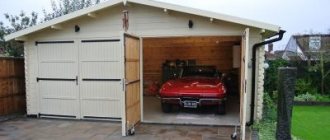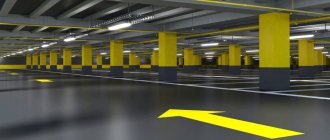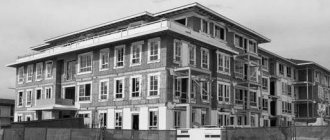You can arrange buildings on your own site as you wish. In this case, fire safety standards and the distance from the fence to the garage and neighboring buildings that have already been erected or are being built must be observed.
There are several legislative documents for the construction of a garage. They do not contradict each other, but operate on different planes. The main ones are fire safety rules, which must be followed strictly. Some standards are advisory in nature.
According to the current legislation of the Russian Federation, a garage is classified as an outbuilding.
Based on Article 51 of the Civil Code, Articles 1 and 17, obtaining permission to build a garage on a private plot is not required.
But this does not mean that it can be built anywhere.
The neighboring plot is empty
SNiP regulates the distance when constructing a garage from the fence, on the side and in front, as well as from the nearest neighboring building and the red line. In this case, the right of the first developer matters.
A garage on an undeveloped plot can be located no closer than 1 meter from neighbors
If construction of a house and outbuildings on neighboring plots has not yet begun, then the garage can be placed at a distance of 1 m from the neighboring fence. The measurement takes place from the extreme point of the base to the demarcation line, in this case, the fence.
According to SNiP, wastewater from the roof should not fall onto someone else’s property. The passage between the building and the fence must remain free.
A free passage between the garage and the fence ensures good drainage of water from the roof
Before building a garage, talk to your neighbor. If he already has an approved development plan for the site, primarily a house, then this is equivalent to the start of construction and is legally valid at the level of existing buildings.
Detached garage
Construction of a detached garage is quite an expensive undertaking, especially if it is approached with due thoroughness and the building is designed in the same architectural style as the house and other buildings. They increase the cost of building a detached garage building and the cost of laying communications.
When designing a garage, it is necessary to provide not only for its placement, taking into account the requirements of SNiP, but also for an access road and a turning point. Therefore, it is better to locate a detached garage not in the depths of the site, but in close proximity to the entrance.
The advantages of this solution
The construction of such a structure can begin even several years after the construction of the house. Or - when the plot is purchased with a cottage. In addition, there are no restrictions on the size of the garage - as long as it fits into the site.
Therefore, when constructing a capital structure, you can plan a place for a second car if its purchase is planned for the future, or take into account the possibility of purchasing a larger car.
With proper planning and project selection, a detached garage can become more than just a place to park a car. In this room you can store bicycles or scooters, garden equipment and tools, and it is convenient to place a workshop here. But only for this you need to choose the right size of the garage and its layout.
Minuses
A detached garage, despite all its attractive qualities, also has some disadvantages. One of the most unpleasant is the need to walk to the house in any weather along the street. This is especially true for owners of large plots when the garage is located away from a residential building. In this case, you will either have to put up with this inconvenience, or build a covered gallery connecting it to the house.
Another drawback is the need for significant investments of funds, already discussed above.
The neighboring plot is built up
If there are buildings on a neighboring site and work is being carried out to create a foundation, the 6-meter rule comes into force. The garage must be located more than 6 m from the nearest neighboring building.
These rules ensure safety in the event of man-made accidents and other types of damage and fires that occur.
In the event of a fire, the fire should not easily spread to other buildings
During simultaneous development and when a neighbor is building later, but wants to locate the house closer to your existing garage than 6 meters, an agreement is concluded between the neighbors. It is legally certified.
Where is the best place to build a garage?
We looked in some detail at the features of built-in, attached and detached garages. Each of them has its own advantages and disadvantages.
The choice of one type of garage or another depends on the preferences of the owners, the characteristics of the site and the budget. Since we are talking about a capital structure, a decision should be made after carefully weighing all the pros and cons. After all, simply by not correctly calculating the size of the room for a car, the ease of access to it or the slope of the drive, you can not only experience inconvenience in operation, but also damage property.
In addition, in the 21st century, a garage for at least one car (and preferably two) is an essential element of a country cottage. Without it, the liquidity of a property is significantly reduced.
That is why it is important to consider this issue no less thoroughly than other aspects of purchasing or building a future home.
Did you find this article helpful? Please share it on social networks: Don't forget to bookmark the Nedvio website. We talk about construction, renovation, and country real estate in an interesting, useful and understandable way.
Distance from red line
The second part of the garage location rule concerns the so-called red line. This is usually the front boundary of the property facing the road. The line along which all government communications, underground and overhead, pass:
- water pipes;
- sewerage;
- power line;
- connection;
- gas supply.
The red line with communications must be at a sufficient distance from the garage
In addition to the systems listed above, others may also pass through.
The garage should be located 5 m from the red line. By complying with this condition, you comply with the requirements of local authorities and road inspectors. The car in front of the garage must be parked on the site, not occupying the roadway or sidewalk.
The parking space between the garage and the road should not block the passage of other cars on the road
The distance from the garage to the fence can be reduced, and even made into one line, if the fence is moved a meter from the red line towards the site and coordinated with local government and fire safety authorities.
The fence must be moved along its entire length, and not just in front of the garage, creating a free area for passage in the event of an emergency or fire.
A garage with a parking space must be located on the site
Additional requirements
At what distance from the property line can a garage be located if there is an alley on the side? Regardless of the width and intensity of the dirt road or just a pedestrian area, the house for the car should be located no closer than 3 m from the side fence and the street.
This requirement of SanPiN is based on fire safety; in the event of an emergency, transport must pass freely between areas.
Acceptable layout of the garage on the site
The provision applies to the house, all outbuildings and structures related to small architectural forms:
- gazebo;
- pergola;
- awnings;
- greenhouse;
- summer houses.
Requirements for a garage built into a house are imposed on the general principles of a permanent building
The boundaries are determined at a distance of 6-10 meters from the fence, depending on the material of the walls. For wooden houses - 15 m. It is prohibited to arrange living rooms above the garage:
- bedrooms;
- children's;
- kitchen-dining rooms;
- living rooms.
Garage in the house
Equipping a garage directly in a residential building, or constructing an extension adjacent to the residential part, has a number of advantages and disadvantages. The proximity of the location makes access easier, especially in bad weather. In this case, it will also be easy to install communication lines and install a general security system.
But the close proximity to the parking lot, especially in cases where maintenance and repairs are carried out in the garage, becomes not only the cause of excessive noise: the emitted motor gases are toxic and harmful to health.
If this option is chosen, temporary living spaces, such as a gym or library, should be located above the garage. It will also be necessary to take additional measures to protect against accidental fire.
Before you build a garage with your own hands, you need to take into account the topography. Drainage and relief correction may be necessary.
Recommendations from a specialist on choosing a place to build a garage
When constructing an inspection pit, it is necessary to conduct geodetic exploration of the soil and soil waters. If the location is close, choose another place or waterproof the pit. This is explained in the following video:
When developing a project, experts recommend immediately planning to build a garage on the north side of the site. Then it will not block the sun for plants around the house and limit the light flow.
The location of the garage in the northern part of the site is recommended, but not mandatory
This point of the designers is advisory in nature and is more suitable for farmers who use the site for growing vegetables and fruits.
How to get land for a garage
Advertisements for the sale of land plots for construction can be seen on any real estate website, but not everyone knows how to legally obtain land from the municipality for a garage. The procedure must begin by contacting the local administration. The lands of settlements are owned by the state, and the local municipality acts on its behalf and makes decisions on the provision of free space. In this case, land plots are issued on a first-come, first-served basis or based on the results of auctions.
It is advantageous to get a place for a garage at auction; the advantage of this method is that you do not have to stand in line. All that remains is to win the auction and pay for the opportunity to erect buildings on the selected site. In sparsely populated areas, it is possible to purchase a plot of land by paying only the cadastral value or receiving the land for free.
If you are interested in what category the land under the garage belongs to, then the resulting land can be provided for rent or ownership. Having won the auction, a person can rent a plot, and after construction, register it as property on preferential terms. For registration you will need to pay 3.5 percent of the cadastre.
The procedure for providing a land plot for a garage from the state is regulated by Article 39.6 of the Land Code of the Russian Federation of October 25, 2001. If a share in a garage cooperative is acquired, then a change of purpose is not required for privatization. A citizen leases a non-privatized object from the state.
At any time, the municipality can give away an existing plot for the construction of an infrastructure facility. But only the owners will be able to receive monetary compensation with which to build a new building. A person has the right to sell, exchange, and inherit privatized property.
Many people build a garage on a plot of land, but when planning a separate room on a summer cottage there are also certain legal norms. To register ownership rights to a building, you will need to issue a technical passport and make an entry in Rosreestr. This procedure is described in Article 25 of the Federal Law, which regulates the state registration of rights to real estate and transactions with it.
Distance from the fence during garage construction: documentation and SNiP standards
The following standards apply to detached and attached garages built on private plots for personal cars:
- SNiP 2.07.01 – 89. “Urban planning. Planning and development of urban and rural settlements";
- Urban planning complex of the Russian Federation 12.29.2004, No. 190-FZ;
- “Fire safety rules for buildings and structures” dated 21.01. 1997;
- Fire safety standards No. 53.13330.2011.
The garage should be located 1 m from the neighboring fence, and 6 m from the windows, veranda and walls of the neighboring house
The measurement is taken from the edge of the protruding plinth or walls, which stands out more outward, to the line of the nearest element of the neighboring building. Balconies protruding above the level of the roof of the building for the car are not taken into account unless they have columns and capital supports of another type.
Maintaining the required distances between the garage, the fence and the nearest building on the neighboring site will protect you from administrative liability, disputes with neighbors and forced demolition of the building
Violation of the requirements of SNiP 2.07.01 - 89 and SNiP 21.01 - 97 will not entail criminal punishment, since in relation to outbuildings, which include garages, regulatory documents are advisory in nature.
Fire safety regulations must be observed; violation of them is punishable by fines and even demolition of structures.
You can ignore them on your site, but after construction the garage must be registered with the BTI, so troubles may arise.
Is it possible to bypass SNiP
Under certain conditions, it is possible to build a garage in violation of these standards. This requires a written agreement with the neighbors, which should be notarized. This document is valid for three years, after which it must be renewed. The garage must be built in compliance with all fire safety standards discussed above.
You can also build a garage next to your neighbor's. You can also install a garage in such a way that one of its walls replaces part of the fence. In the latter case, a conflict with neighbors may arise if your building obscures their plantings. Therefore, before starting construction in this way, it is necessary to agree with the neighbors and conclude a written agreement.
Important! A written contract is concluded with specific people. If the neighbors sell the plot, a conflict may arise with the new owners.
At the same time, the statute of limitations for the claim is 3 years, and if no problems arose during this time, then the construction can be considered legal.
Accommodation in the basement
A garage can be built not only as a separate building or an extension to the house, but also in the basement of the house itself. According to SNiPs, the ground floor is recessed into the ground by no more than half the design height of the room, and the upper part of the floor is located above the ground surface by no more than 2 m.
As for the installation of a garage in the basement, SNiPs recommend sealing its floors and walls so that exhaust gases and odors do not penetrate into living spaces. For this purpose, various insulating compounds are used. It is also necessary to make separate duct ventilation. In the basement, special attention must be paid to waterproofing. Walls and ceilings must be made of non-combustible materials.
Accommodation in a residential building
If the garage is located in the house itself on the ground floor, the rules here are the same as when installing it in the basement: duct ventilation and construction of walls and ceilings from fire-resistant materials. If the windows of other rooms are located above the entrance to the garage, a canopy with a width of 0.6 m must be provided above it.
Placement close to home
If the garage is adjacent to a residential building, then the distance from the garage and from the house to the property line is measured separately. In this case, there must be at least 3 m from the house to the property line, and at least 1 m from the garage. The garage can also be attached to an outbuilding.
As for parking a car on or near the site, there are no regulations for its placement. It is important that a parked car does not make it difficult to travel along the street and does not block the entrances and exits of neighboring areas.
SNiP standards are in the nature of recommendations, but experts advise adhering to them strictly. If your garage is built in violation of regulations, and your neighbors can prove that this somehow infringes on their rights, poses a threat to life and health (for example, violates fire safety standards, blocks a passage that may be needed for a fire truck or ambulance) , then by court decision the building will have to be moved to another place, and in the case of a permanent structure this is not so easy to do.
Fire safety standards
Fire safety requirements include a number of points that will help avoid a fire:
- the supply of electricity from the house to the garage is carried out with an insulated cable in accordance with PTEEP standards, without breaks or bare spots;
- the wire is placed in a metal sleeve;
- fuses are installed at the input;
- light bulbs with protective shades;
- presence of a fire extinguisher in the garage and car;
- no heating;
- floor with anti-slip coating, resistant to oils;
- a box with sand for removing spilled fuel and lubricants and extinguishing fires on the floor;
- outside fire shield;
- do not leave the car with an open fuel tank;
- smoking area outside the garage.
It is better to observe fire safety in the private sector so that outbuildings and the house on the entire site do not burn down
You should not store cans next to your car in the garage. It is better for them to make a room behind the garage with a separate entrance.
Electric heating devices and switched-on power tools must not be left unattended.
Immediately during construction, create paths 70–80 cm wide around the base. They will protect the foundation from wastewater and ensure free passage.










